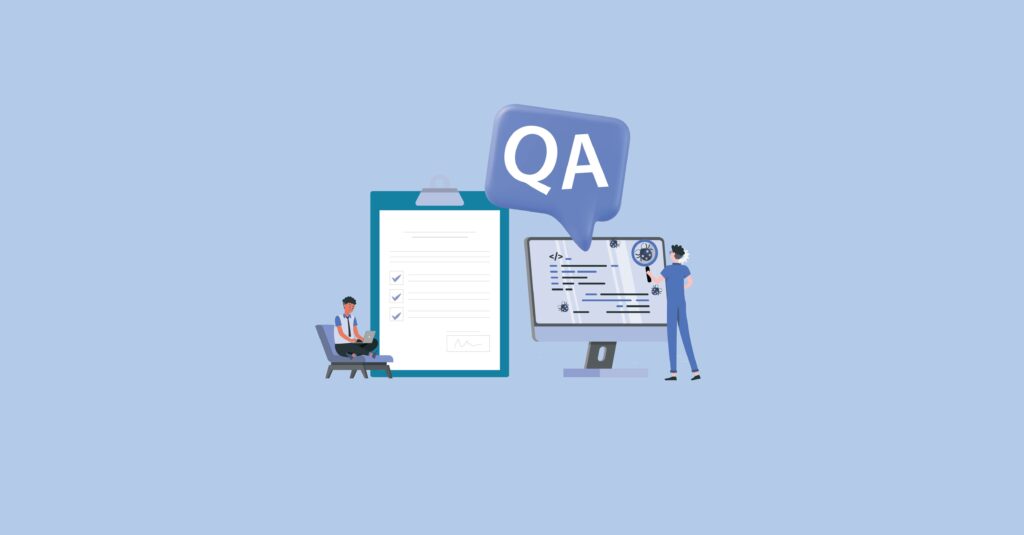Project definition is the initial project phase, where the goals, objectives, scope, and requirements are defined. The project definition phase typically includes activities such as gathering requirements, defining project objectives, and developing a high-level plan for the project.
The primary aim of the project definition phase is to clearly understand what the project entails and what needs to be done to deliver it successfully.
During the project definition phase, the QA lead can fulfil several roles, including
- Requirements analyst: QA Leads can work with stakeholders to gather and
- Risk analyst: QA Leads can identify potential risks and dependencies impacting the project’s quality and timeline. This can help mitigate these risks before they become significant problems.
- Test strategist: QA The lead can develop a test strategy that outlines how testing will be conducted throughout the project. This helps ensure that testing is integrated into the development process and that quality is built into the project.
- Quality consultant: The QA Lead can guide and advise on quality-related issues throughout the project definition phase. This can include identifying quality goals, constraints, and standards and providing recommendations on testing approaches and quality metrics.
Overall, QA can play a critical role in the project definition phase by ensuring that quality is built into the project. By collaborating with stakeholders (client, PM, SA, TA&BA), identifying potential risks, and developing a comprehensive test strategy, QA can help to ensure that the final product meets the necessary quality standards.
What benefits does QA bring to the project if he is involved during the project definition phase?
- Identification of potential defects: A QA lead can help identify possible defects or queries early in the project lifecycle by reviewing the requirements and design documents. This helps ensure that the project team clearly understands the risks associated with the product and can make informed decisions about how to mitigate those risks.
- Identification of quality requirements: A QA lead can help identify and define quality requirements (optimistic, pessimistic, and integration testing scenarios) that are essential for the project’s success. This includes understanding the quality goals, constraints, and standards that need to be met and identifying the risks associated with delivering a product that does not meet these requirements.
- Definition of testing requirements: A QA lead can help to define the testing requirements for the project, including the types of tests that need to be conducted, the testing environment needed, and the test data required. This helps ensure that testing is integrated into the development process from the beginning and that the testing approach is aligned with the project’s quality requirements.
- Better alignment between development and QA: By involving QA leads early in the project, there can be better alignment between the development and QA teams. This helps ensure that the project is designed and developed with testing in mind, which can reduce the risk of defects and improve the overall quality of the project.
- Improved requirements documentation: QA leads can help ensure that requirements documentation is comprehensive, clear, and testable. This can improve the overall quality of the project deliverables and reduce the risk of defects and client dissatisfaction. This can help us reduce the time spent on SIT and UAT bugs, which will save a lot of time.
- Improved communication and collaboration with stakeholders: A QA lead can collaborate during the project definition phase to ensure that quality goals and requirements are communicated and understood. This helps ensure that all stakeholders are aligned in their expectations for the project and can work together to achieve the desired quality outcomes.
Overall, having a QA lead during the project definition phase can help make sure that quality goals and requirements are clearly laid out, that potential bugs are found early on in the project lifecycle, that testing requirements are kept to a minimum, and that everyone involved in the project knows what they expect from it. This helps set the project up for success and ensures that the final product meets the necessary quality standards and is delivered on time.
What might happen if we don’t involve QA in the discovery phase?
There are several disadvantages if a QA lead is not involved in the project discovery phase. Some of the key disadvantages include the following:
- Lack of testing focus: If QA is not involved in the project discovery phase, there may be a lack of testing focus in the early stages of the project. This can lead to requirements that are difficult to test, increasing the risk of defects and making testing more challenging later in the project lifecycle.
- Only complete or precise requirements: With QA involvement, there may be complete or clear requirements, which can lead to misunderstandings and errors later on in the project. This can result in increased project costs and delays.
- Higher risk of defects: If QA is not involved in the project discovery phase, there is a higher risk of defects and issues arising during the development and testing phases. This can result in increased project costs, delays, and decreased customer satisfaction.
- Reduced Collaboration and Communication: QA involvement is necessary for facilitated collaboration and communication between the development and QA teams and other stakeholders. This can result in misunderstandings of requirements, delays, and missed opportunities for improvement.
Overall, not having a QA lead during the project discovery phase can make testing less important, requirements that are not clear or complete, the chance of bugs going up, and communication and collaboration getting worse. These can all negatively impact project success and increase the likelihood of delays and cost overruns.
On the whole, does involving the QA lead in the project definition help?
Yes, involving the QA Lead during the requirement-gathering process can benefit the project’s success. QA leads can provide valuable input during this phase, helping to ensure that the requirements are clear, comprehensive, and testable.
By involving QA Lead early in the process; potential issues or defects can be identified and addressed before they become more significant problems later in the project. This can ultimately save time and resources in the long run.
In addition, QA lead involvement during requirement gathering can help establish a shared understanding of the project’s goals, priorities, and timelines. This can help align expectations and facilitate communication between the development and QA teams and other stakeholders.
Overall, involving a QA lead during the requirement-gathering process can ensure that the project meets the necessary quality standards and is delivered on time.
“The right person in the right place at the right time can have a significant impact.”
Kanchan Somsole and Rajasekhara Reddy










